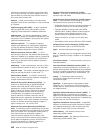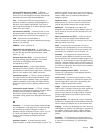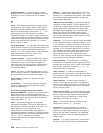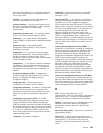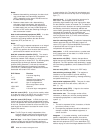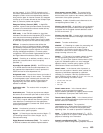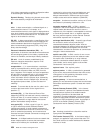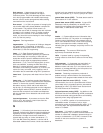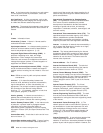arbitrary MAC addressing (AMA). In DECnet
architecture, an addressing scheme used by DECnet
Phase IV-Prime that supports universally administered
addresses and locally administered addresses.
area. In Internet and DECnet routing protocols, a
subset of a network or gateway grouped together by
definition of the network administrator. Each area is
self-contained; knowledge of an area’s topology remains
hidden from other areas.
asynchronous (ASYNC). Pertaining to two or more
processes that do not depend upon the occurrence of
specific events such as common timing signals. (T)
ATM. Asynchronous Transfer Mode, a
connection-oriented, high-speed networking technology
based on cell switching.
ATMARP. ARP in Classical IP.
attachment unit interface (AUI). In a local area
network, the interface between the medium attachment
unit and the data terminal equipment within a data
station. (I) (A)
Attribute Value Pair (AVP). A uniform method of
encoding message types and bodies. This method
maximizes the extensibility while permitting
interoperability of L2TP.
authentication failure. In the Simple Network
Management Protocol (SNMP), a trap that may be
generated by an authentication entity when a requesting
client is not a member of the SNMP community.
autonomous system. In TCP/IP, a group of networks
and routers under one administrative authority. These
networks and routers cooperate closely to propagate
network reachability (and routing) information among
themselves using an interior gateway protocol of their
choice.
autonomous system number. In TCP/IP, a number
assigned to an autonomous system by the same central
authority that also assigns IP addresses. The
autonomous system number makes it possible for
automated routing algorithms to distinguish autonomous
systems.
B
backbone. (1) In a local area network multiple-bridge
ring configuration, a high-speed link to which the rings
are connected by means of bridges or routers. A
backbone may be configured as a bus or as a ring. (2)
In a wide area network, a high-speed link to which
nodes or data switching exchanges (DSEs) are
connected.
backbone network. A central network to which
smaller networks, normally of lower speed, connect. The
backbone network usually has a much higher capacity
than the networks it helps interconnect or is a wide-area
network (WAN) such as a public packet-switched
datagram network.
backbone router. (1) A router used to transmit data
between areas. (2) One in a series of routers that is
used to interconnect networks into a larger internet.
Bandwidth. The bandwidth of an optical link
designates the information-carrying capacity of the link
and is related to the maximum bit rate that a fiber link
can support.
basic transmission unit (BTU). In SNA, the unit of
data and control information passed between path
control components. A BTU can consist of one or more
path information units (PIUs).
baud. In asynchronous transmission, the unit of
modulation rate corresponding to one unit interval per
second; that is, if the duration of the unit interval is 20
milliseconds, the modulation rate is 50 baud. (A)
bootstrap. (1) A sequence of instructions whose
execution causes additional instructions to be loaded
and executed until the complete computer program is in
storage. (T) (2) A technique or device designed to bring
itself into a desired state by means of its own action, for
example, a machine routine whose first few instructions
are sufficient to bring the rest of itself into the computer
from an input device. (A)
Border Gateway Protocol (BGP). An Internet
Protocol (IP) routing protocol used between domains
and autonomous systems.
border router. In Internet communications, a router,
positioned at the edge of an autonomous system, that
communicates with a router that is positioned at the
edge of a different autonomous system.
bridge. A functional unit that interconnects multiple
LANs (locally or remotely) that use the same logical link
control protocol but that can use different medium
access control protocols. A bridge forwards a frame to
another bridge based on the medium access control
(MAC) address.
bridge identifier. An 8-byte field, used in a spanning
tree protocol, composed of the MAC address of the port
with the lowest port identifier and a user-defined value.
bridging. In LANs, the forwarding of a frame from one
LAN segment to another. The destination is specified by
the medium access control (MAC) sublayer address
encoded in the destination address field of the frame
header.
broadcast. (1) Transmission of the same data to all
destinations. (T) (2) Simultaneous transmission of data
to more than one destination. (3) Contrast with
multicast
.
Glossary 449










